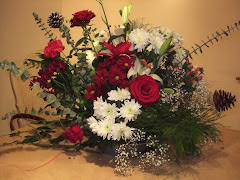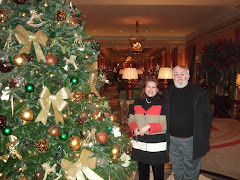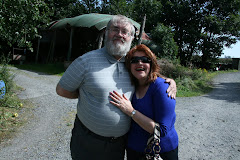Tuesday, 16 December 2008
Hi Robert, I have never seen Dr. Terrors House of Horrors. But all figurative paintings have an abstract element to them. In every painting you will discover either a circle, a rectangle, a cube, a pentagon or any other geometric figure to bring the picture together. That is called composition. For e.g. if you see here, as an experiment the first picture with half closed eyes, you will discover that I have use circles to depict the top of the trees, and are arranged in a triangle to bring the eyes, towards the middle of the picture. The mountains, in its simplest round shapes are also enclosing the sheep in the middle. Anyone who wants to attempt to do a painting, has to think in those basic abstract forms first, before anything else can be developed, it is, if you like, the skeleton of any painting.
Subscribe to:
Post Comments (Atom)
































































.jpg)
.jpg)










































4 comments:
Hola Maria
Likewise in the Mother and Child the wallpaper is vertically striped, because horizontal stripes would only lead the eye astray.
Given that in the history pf painting most things will have been tried, I was wondering if there had ever been a "democratic" or "egalitarian" painting in which there is no composition and in which there is nothing to direct the viewer's eye to anything in particular?
Well done Robert, you did catch the the vertical stripes as the devise used to lead the eye to the main subject, although as this subject was bang in the center anyway, and given that the Mother & Child covers most of the surface painting, that is naturally where the eye will go. So maybe it was an over kill !
Well, I really do not understand what you mean by a " democratic " or " egalitarian " painting. If the painting does not have a proper composition, then the eyes drift away somewhere else, making the painting uninteresting, without a good composition, everyone will not give this painting not even a quick glance and move on to see something else that will catch their attention. The trick is to make people stop and watch it. If you fail to do this, then you have failed as an artist.
And not everything has been tried, as you have just stated, hopefully Art still has the ability to evolve and be innovative, either by the new materials which have been recently invented or as science evolves too, these leaps of progress are also translated into the visual arts as well. These days, people can air spray by touching a button in their computers but there are still the traditionalists like myself, who still prefer to use real paint and brushes and also, why not ? A real air-brush too. The question whether painting will disappear as an art form would be like stating: "As everything has been said already, there is no point in writing more books either ! My answer to that is: Yes, there is, so long as there is a human soul who feels and thinks there will be painting and books too. And judging by the increasing prices paintings are still commanding at the auction houses I think painting as an art form is not going to disappear any time soon Robert.
Ah, I didn’t say that such a “democratic” painting would be any good, Maria, just that I wondered if it had been tried. The sort of thing I had in mind was cubism, which (I’m told) attempts to reprersent an object from every direction at once, hence the point of view of the person looking at the painting is no longer privileged and all points of view are somehow “equal.” I was wondering if there had been a school of painters who put no effort at all into their paintings from the point of view of composition, simply painting the objects just anywhere on the canvas.
Of course, painting will not die out and nor will music or poetry or any of the other arts. It doesn’t matter what has gone before, a great artist will always rise to the challenge. Look at poor Beethoven – he had to follow Mozart. But he managed it.
Robert, you were wondering if there had been a school of painters who did not use composition, simply painting the objects at random. I don't think you need schooling for that Robert. Very young children's paintings usually do not have proportions in relation to other objects, for example: drawing their mother bigger than their house next to her, with no perspective, no shadows, just representing their world, without worrying about these devises.
Post a Comment